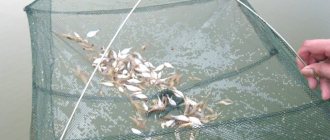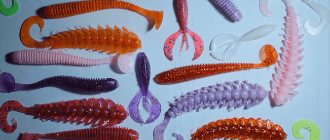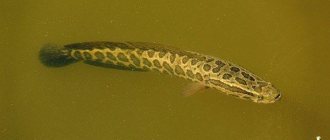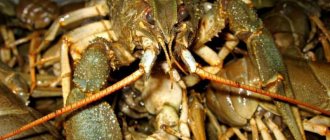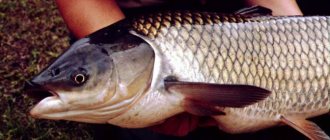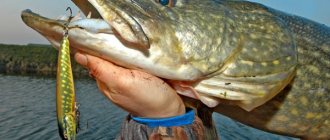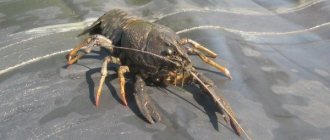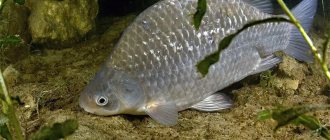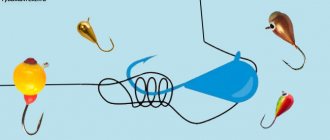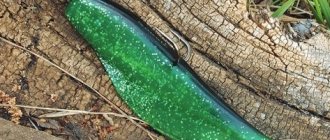Features of winter fishing
There are reservoirs in which crayfish remain active almost the entire winter season. This is due to the presence of warm water in the bottom horizon and suitable bottom topography, where they build shelters. You need to look for crayfish in winter at those points where the water maintains a comfortable temperature until the most severe frosts. Perhaps these are areas where warm springs flow at great depths. And although there are relatively few such reservoirs, they still exist. There, cancer continues to manifest itself almost throughout the winter, and it is found everywhere, with the exception of small areas less than 1 meter deep.
If there are no springs or other sources of warm water, the crayfish begins to hide in shelters at great depths. Males stop showing activity, and females intensively collect food and stock up on the necessary energy before the upcoming spawning. Young animals and small individuals are especially active, while old ones remain in burrows and do not swim to the surface.
The list of the most promising places where you can find crayfish regardless of time includes the following areas:
- Contrasting relief with significant differences in depth.
- Muddy, silted and not very clean bottom.
- Rocky shore and clay bottom.
- Areas with shallow depth, but a clean and rocky bottom.
- Deep holes.
- Large cramps.
If in the summer the main part of the crayfish’s diet is plant food, then in winter the animal turns into an avid predator who loves to hunt small fish. During this period, he is interested in roach, bream and silver bream, and the meat of pike or perch is not a valuable find. Given these preferences, fishermen often lure crayfish with pieces of fish, for example, sections of the dorsal part, which emit a strong specific aroma.
The main thing to remember is one feature: with the arrival of cold weather, which causes a decrease in water temperature, the smell spreads throughout the water column much worse than during the warm period. Of course, if in summer a crayfish could attack even a living fish, noticing it from a long distance, then in winter it has difficulty paying attention even to dead, stale prey. To enhance the attractiveness of the fry, it is necessary to make several cuts on it, up to the formation of blood discharge.
Catching crayfish using a crayfish trap
We already have a separate article on catching crayfish with crayfish traps, but we’ll look at it again.
Types of crayfish
Open type crayfish Closed type
Depending on the fishing conditions and the preferences of the fisherman himself, the types of crayfish traps are selected. Which one to choose depends on the situation and the expected catch, but any of the crayfish traps should be used at a depth of 1.5-2 meters.
Open type
They are an extremely simple design that you can also make yourself. As a rule, when opened, it is a ball or cone that is attached to a stick pointed at the end and stuck into the bottom. An alternative option is to attach a weight to the bottom of the cage that is heavy enough to prevent it from being washed away by the current. Well, of course, a strong rope is tied to each crayfish trap to easily remove the structure back from the water.
Closed type or night light
Closed crayfish, also known as nightlights, generally provide the best results for crayfish fishing. There are several types of such crayfish traps, their design is much more complex than open-type traps, but they are all made of an aluminum or steel frame. Dimensions: bottom 30-55 cm, upper part 1.5-2 times narrower, that is, 15-25 cm. The height of such traps can reach 25 cm. The hole for the “entry” of the crayfish should be at least 8 cm.
There are also such types of “night lights” as gobies. They can be cylindrical or rectangular. They have more pharynx windows, but the principle remains the same. Large dimensions are a disadvantage of such crayfish traps, since they are difficult to transport and use in very small bodies of water. Sinkers are placed inside - stones are best suited. In the center is the bait.
Trick: if the trap slams shut in the water, tie a rope to the edges of the windows, from which there will be a strong float that will keep the trap doors open. You can measure the depth with a marker float or a coastal wireless echo sounder.
Such traps are checked 3-4 times during the entire fishing period, or every 1-2 hours.
Video on catching crayfish using a crayfish trap:
What to use as bait
Some claim that crayfish are attracted to rotten, stale bait, but this contradicts even common sense; fresh food fibers are better absorbed by crayfish, while rotten food can harm it. Yes, the crayfish will easily smell the smell of such bait, but it will “bite” on it quite reluctantly, if at all, because it may not be so hungry. Therefore, let’s consolidate and destroy stereotypes - the fresher the bait, the more willingly the cancer will bite on it.
Small fish
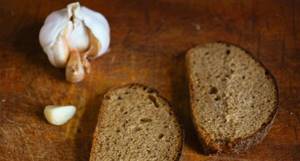
Garlic with bread
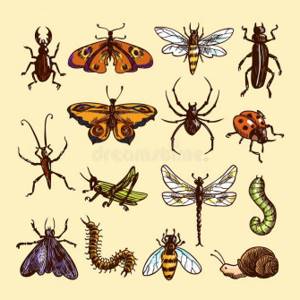
Insects
garlic, worms, frogs, cake, peas, corn, meat of birds or small animals, shellfish, large insects, larvae, elodea are also suitable . Crayfish is quite omnivorous, but there is one rule: in spring (April, May) and summer (June, July, August, September) it is more inclined to choose plant baits, while in winter (December, January, February, March) and autumn ( October, November) – animals. But this does not mean that, for example, in May you cannot catch a perch, skin it and catch a good crayfish.
Place the bait in the core of the trap in large pieces so that it does not leak and fall into the pond.
Gear and methods
When trying to understand how to catch crayfish in winter, it is important to pay due attention to the choice of gear and fishing methods. With the arrival of winter, the range of possible adaptations is significantly reduced, which is explained by the appearance of an ice crust on the reservoir and a significant change in the lifestyle of animals. But even in winter you can catch crayfish productively, provided that the right equipment is used . Among them:
- Volokusha (Draga).
- Rakolovka.
- Rachevnya.
A drag net for catching crayfish is a fairly catchy version of winter gear that gives good results in open water. The design resembles a kind of mesh bucket that needs to be pulled along the bottom in promising places where crayfish can live.
When making a dredge for catching crayfish with your own hands, you need to take a metal wire, on the basis of which a rectangle with a diameter of 0.8-1 cm will be created. Then a mesh with a bag with many small cells will be stretched over this blank. A cord is tied at the top.
The next steps remain very simple, because all that is required of the fisherman is to throw the dredge into the water column, and then lift it up at a certain speed, repeating such manipulations until the first prey is caught.
A significant advantage of the tackle is its casting range. An average person with good physical characteristics can throw a dredge at a distance of up to 50 meters without much difficulty.
Making tackle with your own hands is relatively easy. It is enough to use the instructions for making a dredge for catching crayfish, drawings and useful recommendations.
Do-it-yourself dredge for catching crayfish. Catching crayfish on a dredge in winter. How to catch?
This article will focus on catching crayfish in winter. As everyone knows, crayfish live only in clean water, living in burrows, under stones and snags.
Their diet consists mainly of plant foods (water lilies, algae, elodea). Among animal food, it is worth noting a variety of worms, fish and crustaceans.
In winter, they do not change their place of residence, but simply sink much deeper, where the water does not freeze and its temperature is more or less stable. From late autumn to early spring, crayfish lead an inactive lifestyle, staying in their shelters for 20 hours a day.
The vital activity of cancer during the winter period decreases somewhat. Unlike males, females lead a normal, active lifestyle in winter, because carry future offspring under their tails.
Among fishermen, the most popular baits for crayfish are fish, river mussels or frogs. But still fish is the most popular.
Cancer eats roach, bream, and silver bream with pleasure. I do not recommend using perch and pike as bait.
From personal experience, it is better that the bait is fresh. The smell of fish becomes stronger if the carcass is cut along the back to the vertebra.
You can also use crayfish as bait. In this case, only the neck and large claws are used.
Catching crayfish in winter is almost no different from catching crayfish in summer. Late autumn and winter are a busy time for crayfish lovers.
Crayfish are caught on crayfish traps, crayfish traps and merezhs. If there is already ice on the river, a hole is cut to install a fence or ditches are cut to fit the width and length of the fence.
If the ice on the reservoir has not yet frozen, you can catch crayfish with a dredge. The gear is simple, but very effective.
With a dredge you can catch crayfish, even at a distance of 40-50 m from the shore at almost any depth. With all this, you will remain dry while on the shore.
Even in winter you can catch crayfish with your hands. In general, there are quite a few ways to catch crayfish, both in winter and summer.
Catching crayfish using crayfish traps is one of the most common and simple fishing methods. The composition of such a crayfish includes a wire ring (as a rule, steel wire with a diameter of 3-6 mm or stainless steel wire with a diameter of 3 mm is used for crayfish) with a net stretched over it.
Ring with a diameter of 700 - 800 mm, cell size - two “fingers”. The size of these cells will allow only large crayfish to remain in the crayfish trap.
The mesh stretched over the ring is a “sack”. Three cords are tied around the circumference of the ring, which are connected and go into the main cord.
A float is attached to the end of the cord. The length of the cord depends solely on the depth of the reservoir where you are going to catch crayfish.
You need to put pre-prepared bait in the crayfish trap. For greater efficiency, use several crayfish traps with different baits.
After a few lifts, it will immediately become clear to you which bait is more effective. It is worth using in the future.
The fish catcher with bait is lowered to the bottom, and the remaining cord is fixed to a float or to a stick placed across the hole. C - every hour or so, you need to check the crayfish catcher, select the catch, or add bait if necessary.
The rachevnya is a cylindrical mesh stretched over a round metal hoop. Nowadays hoops are made from galvanized wire.
Previously, they were made from willow or cherry twigs and in the center of the mesh they knitted a stone, a piece of iron, or a bag of sand for guying. The diameter of the hoop is about 50 cm.
Three or four thin cords of the same length are tied to the hoop, at an even distance, in order to avoid skewing the rope, and connect them together with a knot, into a loop, which is threaded through a strong cord for lowering and raising the tackle.
The bait is tied to a net stretched along the diameter of the hoop. The tackle is lowered to the bottom.
A more effective version of the trap is a trap with two hoops, which are located above each other at a distance of 5-10 cm. The trap, lowered to the bottom, folds, and when pulled out of the water, the mesh stretched between the hoops prevents the crayfish from escaping.
Crayfish meshes are a more simplified version of meshes for fishing. Based on the location of the neck, crayfish hems are divided into two types: standing hems, the neck of which is located in the upper part of the trap; lying hems, the neck is located at one or both ends of the trap.
The design features of standing hems are that they have one neck and a conical, pyramidal or hemispherical shape. The meringues must be lowered in a vertical position, with the neck up.
Their bottom shape can be round or pyramidal. Currently, the most well-known model of a standing fence is a domed fence, which has the appearance of a compressed hemispherical shape with a round bottom.
The hoop at the bottom has a diameter of 35-45 cm, the diameter of the neck is 10-15 cm. The height of the hem itself is about 15-30 cm.
The bait is attached across the fence. They pass a twig with bait attached to it.
One split end of the twig is attached to the mesh. A twig with bait is also attached to the lower part of the neck.
The bait can be hung on a hook or a piece of fishing line in the center of the line. And - also, catching crayfish in winter will not be so comfortable if you do not take the issue of clothing seriously.
Clothes should be comfortable, not too hot and not restrict your movements. Then any winter fishing will be a joy for you.
And here's what you need to know: Catching rudd with a float rod
Ingredients: Fish broth - 400g, crayfish - 4 pcs. For minced meat: fish - 60g, bread - 25g, cream - 30g, egg - 1/2 pc.
Butter - 30g. Boil the crayfish, remove the necks and claw flesh.
Make crayfish oil from the shells (except for the main shell). To do this, dry the shells, crush them, fry them with butter, then pour the oil into a bowl with water, stir a little (so that the shells settle to the bottom) and let cool.
Mince the pulp of pike perch, whitefish, pike, perch, burbot or other fish 2-3 times, add eggs, melted butter, black peppercorns, bay leaves, salt, ground pepper, cream, crushed crackers or stale bread, soaked in water and squeezed bread.
Mix the whole mass thoroughly.
Dry the crayfish shells, fill with minced fish, pour over the fish soup and cook. Put crayfish necks and crayfish oil there. Add the claw pulp to the minced meat for the shells.
menstois.ru
It is allowed to catch crayfish nine to ten centimeters long. The measurement is carried out as follows. The body itself is measured from the eye line to the tip of the tail. It is allowed to use no more than 3 shells per person. The diameter of each tackle is more than 0. Probably many people don’t know, but catching crayfish by wading or diving is also not allowed.
How to catch crayfish with crayfish and how to make them yourself. What baits are most suitable
You will be fined for such an act. Raklovki, or otherwise crayfish or racheshni, are quite convenient and catchy fishing gear.
They are inexpensive, and if necessary, you can make them yourself. These gears may have different designs.
For the simplest one you will need some mesh, wire and wood. The easiest to make is the so-called crayfish - a grip very similar in appearance to a plate.
It can be made from wire or a regular wooden circle. If the crayfish is round, then its optimal dimensions are from fifty to seventy centimeters.
You need to stretch the net over this circle so that it can sag in the center. If you need a crayfish trap for deep fishing, then you need to tie 3 or 4 ropes to it and connect them with a knot to which a rope is tied, with the help of which the tackle will rise and fall.
A float is attached to the end of foam or other material. This gear is suitable and crayfish can also be caught in it in winter.
For fishing in the shallows, another tackle is better suited; its difference from the one described above is that the float needs to be replaced with a pole, which will need to be stuck into the ground during fishing. The bait must be tied to a pole or directly to the center of the net.
A rack has a similar design, which consists of a circle of wire or a wooden bag in the shape of a cone with a sinker fixed in the center.
Dredge baits
If you want to catch crayfish with a dredge, you need to pay special attention to the choice of catchable baits . It is unlikely that a crayfish will swim into a trap if there is no bait in it or nearby, or if it does not like the food offered.
Without a doubt, the best winter bait option is a small fish. As already mentioned, the fry needs to be slightly cut, otherwise it will not emit a specific smell and will no longer attract crayfish.
The use of dredges for winter fishing is becoming very popular for a simple reason. Unlike some other methods, this option increases the comfort of the process, relieving the angler of the need to climb into icy water.
But the drag net also has significant disadvantages, including the impossibility of using it on a frozen reservoir, which cannot be said about other devices, such as a crayfish catcher and a crayfish catcher.
Application of crayfish traps
As for the classic crayfish, it can also be used directly from the ice. The choice of configurations, shapes and types of gear is quite extensive. The simplest of them is similar to a malyavochka and differs only in the presence of additional walls made of metal mesh. These walls are placed at a certain angle relative to the bottom surface. When not in use, the tackle resembles a truncated cone.
The operating principle of the crayfish is very simple and understandable: a suitable bait, usually of animal origin, is placed inside the structure, and then it is placed at a promising point on the reservoir. Having felt the pleasant smell, the crayfish will swim into the crayfish trap on its own. As a result, he will find himself trapped with a reverse slope of the wall, from which he will no longer be able to escape.
Another common option is called “merezhi” and is somewhat similar to a mesh cylinder with several stiffeners. The prey enters such a shell from both sides at once through holes in the side. You can also find semi-cylindrical and triangular shells on the market.
In addition, making a winter crayfish shell with your own hands is relatively simple, and many craftsmen claim that the homemade version is much better than store-bought ones.
Making homemade crayfish shells
Crayfish are not a fish, and there are not many ways to catch them. You can catch a crayfish with a fishing rod only by accident, walking in shallow water, turning over stones and driftwood in the cold - crayfish love clean, running, cold water, a rocky bottom, separately submerged snags and other natural obstacles. For this purpose, a crayfish trap was invented.
Place and time
These chitinous representatives of the bottom fauna are active almost all year round. You can lure them even in winter if you correctly guess their habitat in a given body of water. But the best time is from mid-June, when the crayfish finish molting and spawning, until December. Then they crawl into their holes and practically never leave them until spring.
The installation location of the crayfish also needs to be chosen based on the bottom topography, current and other nuances. Crayfish do not like open places and rarely crawl out onto the sand. But a quiet backwater, thickets of reeds or a bottom strewn with stones and snags - this is their element.
There is somewhere to hide here, and the current does not carry away potential prey. After all, crayfish mainly feed on dead fish and frogs, but they will not refuse mollusks, snails and drowned birds. They find food thanks to a well-developed sense of smell.
They can crawl towards the bait that interests them from a fairly large space.
Crayfish design
A closed folding clamshell has several useful properties:
- ease of manufacture;
- ease of use;
- catchability;
- ease of transportation.
Rakolovki are divided into two types:
When fishing with open traps, the crayfish must be taken out of the water and checked at least once an hour, because it is just as easy for crayfish to get out of it as it is to get in. But it is very difficult for crayfish to get out of a closed crayfish trap, which is why they are placed mainly in the evening, and checked only in the morning.
What bait should I use?
However, there is no point in throwing an empty trap to the bottom, regardless of its design. If you don’t put a fragrant bait that is interesting to crayfish, they can crawl right on it and won’t even look inside. The principle of fishing is based on making the crayfish crawl into the trap. The bait most often used is:
- small fish or pieces of fish;
- dead frogs;
- open shellfish;
- cake;
- a crust of bread grated with garlic;
- porridge with the addition of an attractant.
Spring
In the spring, after leaving their wintering holes, crayfish will happily feast on fish, preferring bream, crucian carp or goby. They won’t refuse the purchased one either. Only, before placing the bait in the crayfish trap, it is recommended to dry it a little and make several cuts, so it will smell even stronger.
Summer
Due to the abundance of food in the summer months, crayfish stop moving long distances and prefer to stay in one place. But, if cancer smells some delicacy, it is ready to go even on a very long journey to diversify its diet.
Animal or bird giblets work best as such a delicacy at this time for crayfish. This concept refers not only to the entrails, but also other parts of the carcass (skin, ears, pork cheeks, etc.) and even small pieces of meat.
Again, before using, you should leave them in the sun for a couple of hours to achieve a natural, attractive aroma. But you shouldn’t wait until the bait is completely rotten.
Autumn
With the approach of cold weather, crayfish strive to eat for future use and are ready to grab any food that comes their way. During this active period, they can be lured by almost any strong scent, but garlic works best.
A small piece of rye bread is rubbed heavily with a head of garlic. It’s even better if you put them together through a meat grinder. This type of bait is placed in a crayfish trap wrapped in gauze.
If this is not done, the bread will swell and simply wash out of the trap.
Other types of bait also work flawlessly. And meat, and poultry, and fish, and even cereals, sprinkled with an odorous attractant.
Winter
From mid-December until about mid-March, catching crayfish is difficult, but quite possible. The main thing is to know the bottom topography and their wintering places well.
Crayfish get out of their burrows because they do not hibernate, but they need to eat something. However, cold water carries odors very poorly. This is why you need to know exactly where to place the trap.
The bait for crayfish in winter is mainly meat and offal, but fresh fish, cut into small strips, is also suitable.
The big inconvenience is that you need to cut a large hole in the ice so that the trap can pass through it freely. And since they place it mainly from evening to morning, care must be taken that it does not freeze. To do this, you can put spruce branches or straw on top.
Homemade crayfish
Making a crayfish trap with your own hands at home is absolutely not difficult. To do this you need to choose the right material.
Some craftsmen can make this trap even from a plastic bottle directly on the shore using a sharp knife and several pieces of rope, but the size of such a crayfish cannot provide a large catch.
So it’s worth spending a few hours and making a high-quality trap that will last for more than one season.
To make a regular open shell you will need:
- soft steel wire;
- fine nylon or metal mesh;
- nylon thread;
- rope.
Two rings are bent from the wire. One with a diameter of 50-70 cm, the second - 20 cm. The rings are connected to each other by three symmetrically located spacers made of the same wire.
As a result, it turns out that the upper ring is rigidly fixed, the trap will not fold, turning into a flat pancake, where the crayfish cannot get into. A wide ring is installed in the center of the mesh and tied to it using nylon threads.
Then, carefully straightening the mesh, tie it to the upper ring. A rope is attached to it, which will be used to lower the shell to the bottom and lift it.
A closed-type shell is somewhat more difficult to make, but the set of materials remains the same. This time you will have to prepare not one, but three wide rings. And the little one will remain alone. But if there are two entrances located at two ends, then two such rings are needed.
In the second case, you will also need twice as many spacers. The design feature that ensures efficiency is that the small inlet ring is located inside the large one.
A kind of neck is formed, along which the crayfish crawl inside the shell, but can no longer get out.
Lure attachment
If you simply put pieces of meat, bread with garlic wrapped in gauze, or offal inside, they may simply fall out when installing the crayfish catcher. There are many ways to secure bait in a trap.
You can simply tie it with the same nylon thread or elastic band directly to the center of the mesh. But some fishermen, already during the construction of the trap, make a special pocket from a nylon mesh, where the prepared odorous bait is placed before installation.
The pocket should be located in the middle of the side that will lie on the bottom.
Tactics and techniques of fishing with crayfish
You should choose the right place where crayfish are found and place the crayfish trap in the late afternoon, because arthropods prefer to go out to feed in the dark. Cloudy weather sometimes confuses them: when there is no bright sun, catching crayfish can also bring good results. But the main catch is still at night.
The technique comes down to correctly placing the trap in the chosen location. This can be done both from the shore and from a boat.
If near the shore there is a sharp drop into the depths or other obstacles that prevent you from entering the water, take a long but strong stick with something like a slingshot at the end. This slingshot clings to a rope tied to the trap, and gradually the crayfish is taken to the selected promising place.
Then, by tightening the rope, the trap is slowly lowered to the bottom. It is better to tie the other end of the rope to something on the shore. Crayfish, even in large numbers, are unlikely to steal the crayfish trap, but such a precaution will never be superfluous.
This type of casting requires some skill, so it is better to have a partner.
Installation is even easier from a boat. Having arrived at the chosen catching place, the trap is carefully lowered to the bottom, and a float made of a piece of foam plastic or an ordinary plastic bottle is tied to the end of the rope.
The open shell is checked approximately once an hour. This should be done carefully, being careful not to stir up the water. It is left closed for several hours, often until the next morning.
There is no need to put a large amount of bait. Especially if the design includes a nylon pocket. The goal is to attract the crayfish, not feed them.
One small fish, a piece of meat or offal, a piece of rye bread with garlic is quite enough. Severely rotten fish or meat should also not be placed. It is believed that crayfish love it, but in fact this opinion is erroneous.
If arthropods have a choice between rotten meat and fresh meat, they will choose the latter.
Ban on catching crayfish
In some regions of our country there is a seasonal ban on catching freshwater crayfish. Its deadlines are set by regional authorities responsible for ecology, fishing and hunting. In some places this is almost the entire year, so only the autumn months are reserved for fishing.
Somewhere just a couple of spring months. This ban is introduced in connection with the deposition of eggs by arthropods, during which they molt. Spawning and molting begin in early May and continue until mid-June.
It was during this period that crayfish fishing was prohibited almost everywhere.
Crayfish meat is very tasty, but it is more of a gourmet snack for a certain type of drink than food in the full sense of the word. But catching crayfish is an activity that brings pleasure not only from the catch, but also from communication with nature, time spent in good company, and a good mood.
Source: https://ribaku.info/raki/rakolovka
The principle of operation of the healer
Another popular tackle that can be used to catch crayfish is the crayfish. Like previous devices, it is made of durable mesh and has a cylindrical shape . The base is a metal hoop, the diameter of which is about 50 centimeters. The hoop itself is made of wire with a special coating. For comparison, in the past people used willow twigs.
To weight the structure, a suitable load is placed in the center, for example, a stone or a heavy sinking object. Then 3-4 cords of small diameter with the same length are tied to the hoop, which will prevent the hoop from skewing when lifted from the bottom.
To connect the cords, special knots are used, to which a cord is tied, which acts as a lowering and raising trap. The bait is tied to a mesh stretched over a metal base.
After the gear is equipped, it is placed at a promising point and then checked after a certain period of time. Some craftsmen improve the trap by equipping it with an additional metal image. In this case, the bottom of the structure is connected to the upper hoop with a woven mesh, and the side wall prevents the release of the prey when raised to the surface.
Other devices and techniques
Another unique device that allows you to catch crayfish in winter is a twist. And although the method is considered a relic of the past, some people still actively use it. To create a structure, just take a metal wire and attach a hook to one end and bend the other. Such manipulations will provide the trap with better rotation.

Next, you need to place the twist in the hole at the very bottom, where all kinds of vegetation, snags and other bottom obstacles are present. The wire is twisted around its own axis, causing the algae to wind. Next you need to take them to the surface and sort them out with your hands. In most cases, there are crayfish among the dense plants.
The most extreme way to catch crayfish is by hand. After all, few people would agree to climb into icy water with their bare hands in order to examine the many crustacean burrows at a depth of about one meter. However, many adventurers buy high-quality thermal underwear, wear diving suits and practice this unusual technique. But catching prey in clear water is problematic, although there are good chances there too.
Best lures
With the arrival of winter cold weather, the food supply of crayfish becomes very scarce. This is due to a significant decrease in the amount of food, since any living creature begins to hide in shelters, and scavengers, including crayfish, simply cannot find a source of food. In such a hungry time, the cancer does not refuse any available prey, greedily rushing at everything that floats past and resembles food.
The best bait option is black bread, which is pre-rubbed with garlic. Rye bread, where a small piece of garlic is placed, also attracts crayfish very well. To avoid rapid decomposition of the bait in water, it should be wrapped in gauze.
Crayfish fishermen also lure prey with aromatic pieces of fish or tripe, including rotten ones. However, there is no need to put rotten meat in the crayfish trap, because even the hungriest predators refuse it. When using fry, you can chop it, or you can take it whole, after cutting the carcass to create a specific aroma.
Regardless of the bait used, one fact must be taken into account - in winter the smell does not spread in the water as well as in summer. Therefore, baits should be as aromatic as possible, otherwise they will not attract crayfish.
How to catch crayfish using bait
The methods described above describe how to catch crayfish without bait. Without them, the catch is almost random in terms of catch, and also requires the constant presence of a hunter - a crayfisher. When using bait, fishing for crayfish is more effective. They lure crayfish to traps and constantly keep them near them. The crayfish surrounding the trap can be collected by hand.
There is another effective method for catching crayfish, this is fishing - when the crayfish grabs the bait with its claws, and then you can grab it with your hands or with a net and pull it out of the water. There is only one weak point - the cancer can unhook at any moment and go home. To do this, you need to tie a fishing line to a 1-2 m long stick, and attach the bait to it.
The sharp end of this fishing rod needs to be stuck into the bottom of the reservoir not far from the shore. The bait is placed to the side to attract crayfish. It is advisable to place more of these baits, the more the better. The more crayfish, the more fishing rods you need to use. This bait attracts crayfish from an area of at least 10 square meters. Therefore, such fishing rods should be placed no closer than 5 meters from each other, this is more effective. And occupy an area of no more than 100 meters in length.
During all crayfish fishing, you need to check your fishing rods at least 3 times an hour. When the catch becomes smaller, you need to change the place of fishing. They check the fishing rod carefully, slowly lifting the bait so that the crayfish do not jump off and take them from below. If the stick sways slightly, it means the crayfish is already on the bait and it’s time to pull it out. Next, let’s look at the casting and the girder – somewhat similar to the previous gear.
Only here they already use a fishing line 1-2 meters long to which the bait is tied; at the other end of the fishing line you need to tie a float. You need to tie a load to the rig near the bait. You can also use a simple stick , which is stuck into the bottom, and before that, bait is put on the sharp end of the stick, so that it lies freely on the bottom when the stick is stuck into the bottom of the reservoir. All fishing methods considered use the same fishing technique. Since you need to hold the rod in your hands all the time in order to immediately react to the crayfish that grabs the bait.
Searching for crayfish in the warm season
Unlike the winter season, crayfish are caught in a variety of ways in summer and early autumn. Some people prefer to take them out of their holes with their bare hands, although this is not entirely safe, since the hand can get stuck in the hole or end up in the crayfish’s claws. The most common gear for warm weather are crayfish and crayfish, which allow you to get several dozen trophies from the depths in one cast. And the fishing process itself is considered passive and very comfortable, without any complex manipulations or tricks.
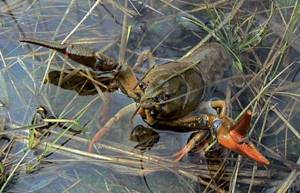
In winter, little changes, except for the need to use more aromatic pieces of fish that emit a specific, intense smell. With this approach, going out onto a pond will bring success regardless of the time of year.
